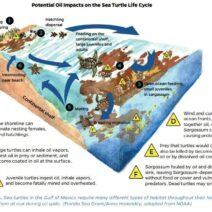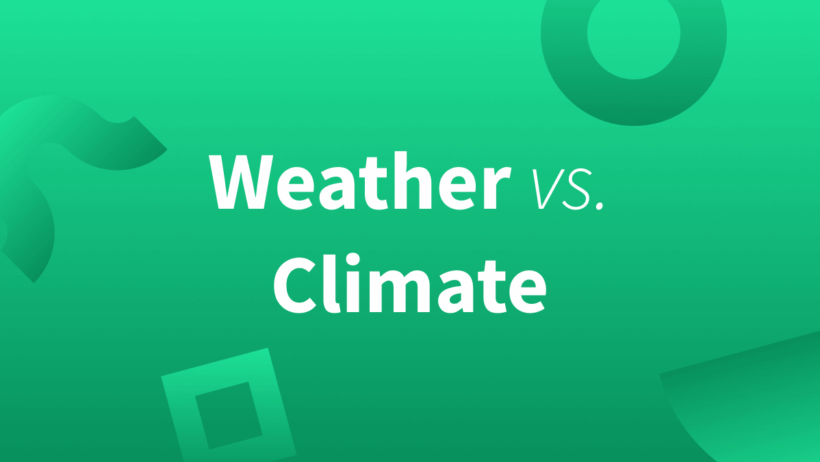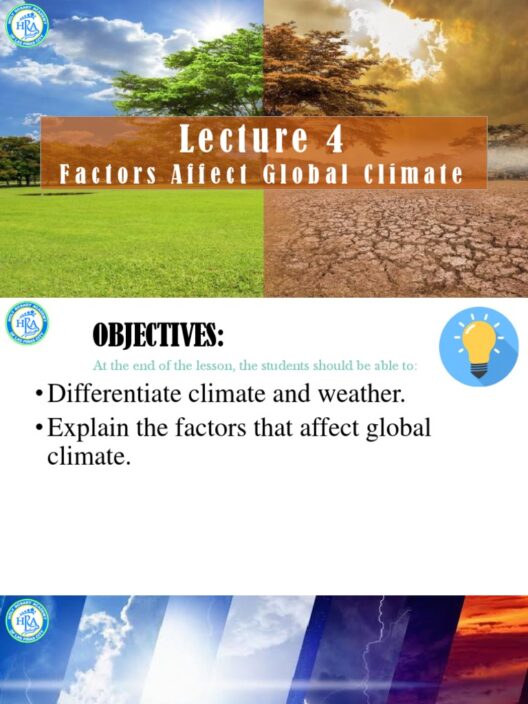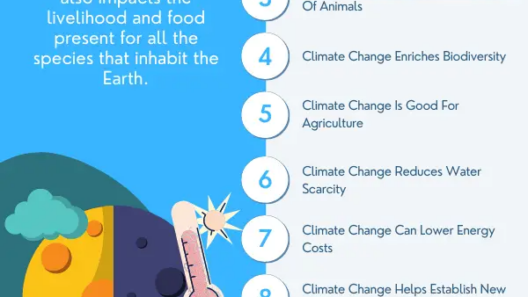The terms “climate” and “weather” are often used interchangeably, yet they describe fundamentally distinct phenomena. Understanding these differences is pivotal, especially in the context of climate change, which has become a pressing issue affecting ecosystems worldwide. Engaging with these concepts can foster a deeper appreciation for our planet’s dynamics.
First, it is essential to delineate what weather truly encapsulates. Weather refers to the short-term atmospheric conditions in a specific place at a specific time. These conditions can include temperature, humidity, precipitation, wind speed, and visibility. For example, a sunny day with mild temperatures and a gentle breeze may be considered pleasant weather, while thunderstorms coupled with heavy rainfall can signal a dramatic shift in atmospheric conditions. Weather can change from minute to minute, hour to hour, and day to day. Meteorologists employ sophisticated tools — ranging from Doppler radar to satellite imagery — to predict weather patterns, providing forecasts that assist in daily decision-making.
In contrast, climate is defined as the long-term average of weather patterns in a particular region over extended periods, typically taken as thirty years or more. The climate delineates the typical conditions of an area, such as whether it’s generally humid, arid, tropical, or temperate. The climate for a particular region significantly influences its ecosystems, habitats, and even the socio-economic activities that thrive there. For instance, the Mediterranean climate, characterized by hot, dry summers and mild, wet winters, shapes not only the natural vegetation found in that region but also the agricultural practices of its inhabitants.
One common illustration to elucidate the difference might be looking at the difference between a fleeting heatwave and the persistent characteristics of a desert environment. A heatwave can alter day-to-day weather, possibly shocking the system with its intensity, while the desert climate encapsulates the long-standing principles that govern aridity and temperatures.
The relationship between weather and climate also underpins a fascinating observation: while weather can be unpredictable and may only be relevant for a short span, climate is foundational and deeply rooted in geographical and environmental factors that influence global systems. Understanding this distinction can lead to a more profound realization of why climate change poses such an existential threat to humanity and the Earth alike. Climate change refers to significant alterations in temperature, precipitation, wind patterns, and other elements of the Earth’s climate system, attributable largely to human activities such as fossil fuel combustion, deforestation, and industrial processes.
Indeed, fluctuations in weather phenomena can serve as ephemeral indicators of climate shifts. For example, an increase in the frequency of severe storms or unusually hot days may signal underlying climatic changes. It is critical to recognize that although individual weather events are subject to variability, the overarching trends that define the climate may exhibit stark, alarming shifts. Rising sea levels, prolonged droughts, and increased greenhouse gas concentrations are but nuances in the larger narrative of climate implications.
The educational landscape, particularly at the Class 9 level, plays an important role in imparting these crucial distinctions. Students are often introduced to basic meteorological principles emphasizing graphs, data interpretation, and observational studies to encourage critical thinking. Concepts surrounding weather patterns — such as air pressure systems and the water cycle — are fundamental building blocks that prepare young minds for more advanced climatic studies. Engaging with resources like Quizlet can further enhance the learning experience, providing interactive revision tools that can assist in grappling with vocabulary related to climate and weather.
Students can utilize these platforms to explore terms like “atmospheric pressure,” “climate zones,” and “weather systems,” fostering a robust vocabulary that will enrich their understanding. The combination of visual learning and self-testing on such platforms can inspire students to not only grasp the differences but also explore the implications of these systems on environmental and social issues.
A deeper curiosity about climate versus weather can also prompt students to engage with pressing ecological matters. As they recognize the overwhelming evidence linking climate change to anthropogenic activities, they can become advocates for sustainable practices. Education that fosters an understanding of how personal choices impact the environment can lead to advocacy for climate action, thus transforming knowledge into empowerment. A well-informed generation is crucial for the future of our planet.
In conclusion, the distinction between weather and climate is not merely academic; it is an essential understanding in today’s world. As weather reflects immediate atmospheric conditions, climate encompasses the long-term trends and patterns that define our planet. Grasping this differentiation adds depth to our comprehension of climate change and its potential ramifications. Such knowledge can embolden individuals, particularly youth, to act and advocate for policies that mitigate climate change effects. We share this Earth, and it is imperative we understand the systems that govern it as we strive for a sustainable, equitable future for generations to come.







